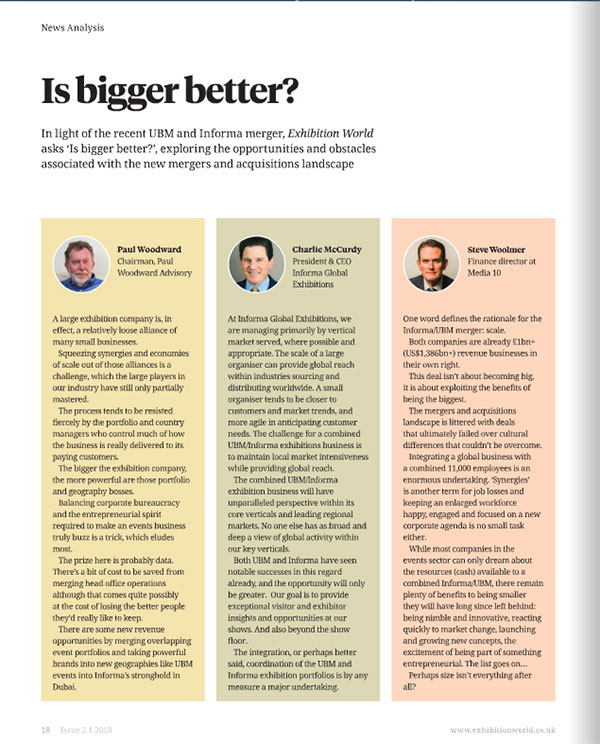In light of the recent UBM and Informa merger, Exhibition World asks 'Is bigger better?’, exploring the opportunities and obstacles associated with the new mergers and acquisitions landscape.
Read the full feature below and the edited feature in the latest edition of EW (Issue 2 | 2018), here.
 Paul Woodward
Paul Woodward
Chairman, Paul Woodward Advisory
The proposed takeover by Informa of UBM has once again raised questions about the benefits and challenges of size and consolidation in the exhibitions industry. When the current top dog, Reed Exhibitions, represents as little as four per cent of the global market and only around 35 organisers boast revenues of over US$100m, we are an industry with no real giants and a very long tail of small players.
But, I have often said that a large exhibition company is, in effect, a relatively loose alliance of many small businesses. Squeezing synergies and economies of scale out of those alliances is a challenge, which the large players in our industry have still only partially mastered. The process tends to be resisted fiercely by the portfolio and country managers who control much of how the business is really delivered to its paying customers.
And, the bigger the exhibition company, the more powerful are those portfolio and geography bosses.
Balancing corporate bureaucracy and the entrepreneurial spirit required to make an events business truly ‘buzz’ is a trick, which eludes most.
The prize here is probably data. There’s a bit of cost to be saved from merging head office operations although that quite possibly at the cost of losing the better people they’d really like to keep. There are some new revenue opportunities by merging overlapping event portfolios and taking powerful brands into new geographies, such as UBM events into Informa’s stronghold in Dubai. But, if you can do something intelligent and interesting with the increasingly valuable data generated by 650 exhibitions, then you may well be charting a course towards the future of our business.
If not, then there’s always the boasting rights at the bar. Being number one is nice but probably doesn’t really add much value to anything.
 Charlie McCurdy
Charlie McCurdy
President & CEO Informa Global Exhibitions
At Informa Global Exhibitions, we are managing primarily by vertical market served, where possible and appropriate. The scale of a large organiser can provide global reach within industries sourcing and distributing worldwide. A small organiser tends to be closer to customers and market trends, and more agile in anticipating customer needs. The challenge for a combined UBM/Informa exhibitions business is to maintain local market intensiveness while providing global reach. The combined UBM/Informa exhibition business will have unparalleled perspective within its core verticals and leading regional markets. No one else has as broad and deep a view of global activity within our key verticals. Both UBM and Informa have seen notable successes in this regard already, and the opportunity will only be greater. Our goal is to provide exceptional visitor and exhibitor insights and opportunities at our shows. And also beyond the show floor.
The integration, or perhaps better said, coordination of the UBM and Informa exhibition portfolios is by any measure a major undertaking. The exhibition business is an amazing business, and re-orienting the mission from ‘show-organiser’ to ‘market-maker’ is a non-trivial undertaking, but very rewarding.
First, the pace of talent and capabilities development continued to be a key constraint on the industry’s growth around the world, but it posed real curbs on the growth potential of smaller and mid-sized events organisers that are confined to one geography – even a large one like the US – or one of a few industry verticals. The rule of supply and demand has not yet been repealed, and the continued growth of our industry is increasingly dependent on access to talented, driven people choosing our industry for their career path and who can work effectively in a global environment.
Second, 2018 is the year that customer experience and sustainability stopped being buzzwords and came into their own as growth drivers and competitive tools. The same was true for innovative (and value-added) uses of event technology. We will be looking into 2019 knowing that these capabilities are expected now—not soon—among the key suppliers and buyers within our markets.
 Steve Woolmer
Steve Woolmer
Finance director at Media 10
One word defines the rationale for the Informa/UBM merger: scale.
Both companies are already £1bn+ (US$1,386bn+) revenue businesses in their own right. This deal isn’t about becoming big; it is about exploiting the benefits of being the biggest. Namely access to each other’s vast international network, leading positions in certain sectors and key growth markets such as China and of course cost savings in the region of £60m per annum can’t be ignored either.
This won’t be without its challenges. As much as both companies highlight massive investment in new technology, our industry is about people.
The mergers and acquisitions landscape is littered with deals that ultimately failed over cultural differences that couldn’t be overcome. Integrating a global business with a combined 11,000 employees is an enormous undertaking. ‘Synergies’ is another term for job losses and keeping an enlarged workforce happy, engaged and focused on a new corporate agenda is no small task either.
While most companies in the events sector can only dream about the resources (cash) available to a combined Informa/UBM, there remain plenty of benefits to being smaller they will have long since left behind: being nimble and innovative, reacting quickly to market change, launching and growing new concepts, the excitement of being part of something entrepreneurial. The list goes on… Perhaps size isn’t everything after all?
Bigger organisers tend to mean bigger shows. In the 2017 UFI Global Insights report, Explori and UFI found that exhibitor satisfaction generally decreases as shows get bigger. (13% dissatisfied for shows 1,000-2,000 attendees vs. 18% dissatisfied for shows 20k+).
Does this come as a surprise and why would large shows see this drop in exhibitor satisfaction?







